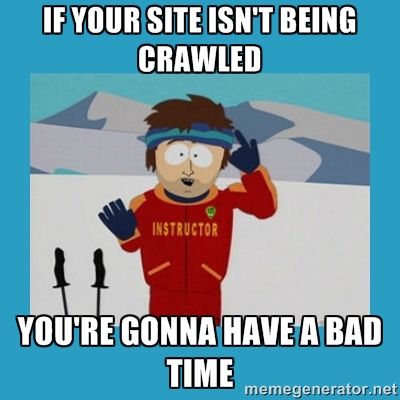How to Perform a Basic Site Audit

Performing a site audit can be a daunting task with a lot of complexity. In this article, we will break down the basic steps for performing a site audit from a user experience and SEO standpoint. As you go through the following steps, keep track of the problems on your site so you can take action to fix them once you finish the audit.
Step 1: Site Crawlability
If your site isn’t being crawled and indexed by search engines, you are missing out on a major opportunity. Let’s see how you can make sure this isn’t happening to your site!
Robots.txt
First, you’re going to want to check your site’s robots.txt file. Robots.txt is useful for preventing certain areas of your site from being crawled; but if used incorrectly it can stop search engines from indexing your site. There are several ways to make your robots.txt file is set up properly. One easy way is to check it using Google Webmaster Tools. Webmaster Tools has a plethora of helpful tools for your site; I won’t go into detail in this post, but you need to use it! If you haven’t yet set up an account, you can learn how here. Once you’ve created an account and verified your site, head to your site dashboard. Under the “Crawl” section, go to the the “robots.txt Tester”. There you can check your robots.txt file for any errors, and edit it accordingly.
Sitemap
Next, you need to make sure your sitemap is set up correctly. A sitemap provides a roadmap for search engines, allowing them to better understand and crawl your site. You can submit your sitemap to Google in Webmaster Tools under the “Crawl” section of the site dashboard. After it’s been submitted, you can easily check for any crawl errors.
Step 2: Basic SEO Optimization
On-page optimization is important from both a user experience and SEO standpoint. A well-organized page will keep users engaged, while enabling search engines to easily understand what the page is about. If you have a larger site (or you’re just feeling lazy), you can save time on this step by using a crawling tool to go through your site.
Page Organization
Take a look at the pages on your site. Are they organized well? Can users easily navigate the page’s content and find what they are looking for? A well-organized page will make proper use of headers (H1s, H2s) to segment the content on a page, guiding users and robots.
Title Tag and Meta Description
Title tags and meta descriptions are some of the most important page elements from an SEO standpoint – they directly influence how your page is displayed in the search results. A title tag is just what it sounds like – the “title” of your webpage. This title is displayed on the browser tab as well as in the search results themselves. The meta description allows you to customize your page description in the SERPs. Keep in mind that search engines still have total control over search results, but they will use your title and meta description much of the time. If your title tags or meta descriptions are too long, they won’t display properly in search results. Title tags should generally be between 50-60 characters long. Although meta descriptions are actually measured in pixel length, I’ve found that they are usually displayed in full if they are 156 characters or less.
Internal Links
As you go through each page, check your links to make sure they are working and going to the correct URL. A crawling tool can be helpful in finding any broken links. Internal links are not only helpful for users, they make it easier for search engines to crawl your site. You’ll also want to keep an eye out for any additional linking opportunities. If the content on one page of your site references something that is relevant to another page, it’s really helpful to add a link to that resource. A simple example of this is linking to your contact page when your content tells users to “contact us today!”. Make sure you don’t overdo it – it’s generally a good idea to only link to something once per page.
Step 3: Content Quality
The phrase “content is king” is popular for a reason; content is the life force of your website. Successful content can make or break your online marketing efforts. You’re going to want to go through the content on every page of your site. Unfortunately, a crawling tool can’t really perform this step for you – it’s important to go through your content yourself to gauge it’s quality and check for errors. This step can be a bit mundane, but it is a necessity! As you go through each page, keep the following in mind:
Grammar, Syntax, Spelling and Punctuation
Your content should be clear, professional, and to the point. A site with spelling errors and poor grammar is not going to appear trustworthy to a user. Having high quality content will also affect your ability to rank in search engines. Although correct grammar isn’t necessarily a “ranking factor” by itself, it is closely related to user experience metrics that are. High quality content has been even more important from an SEO standpoint since the Google algorithm update, “Panda”, was released a few years ago. As you go through each page, make sure your content is coherent and free of grammar & spelling errors.
Relevancy
Not only is it important for your content to be of high quality and free of errors, it needs to be relevant. Your content should be centered around topics and keywords that are pertinent to your audience and industry, while still flowing naturally. Your content needs to serve a purpose to the people browsing your site – whether that’s answering a question, providing entertainment, driving conversions, or otherwise. Doing some solid keyword research is an important step in making sure your content is relevant to your users and properly understood by search engines.
Conclusion
Although this is far from a comprehensive list of the things you need to keep in mind when performing a site audit, it’s a good place to start. Crawlability, basic SEO optimization, and high quality content create a solid foundation for any site to build on. Once you have completed a basic audit of your site, you can begin addressing the issues. Time to get to work!




